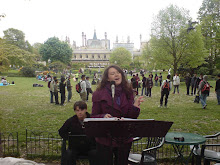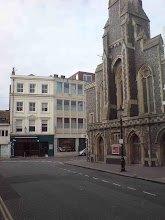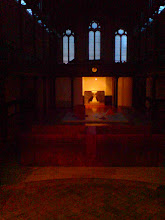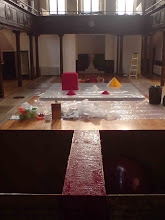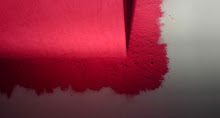
C- curve is a game of significances, it is literally a trick done with mirrors, that inverts the world in more than one sense.
If you think about it, this object, just one of many in AK’s body of work, contains the entirety of his subject matter, much like the way a fragment of a fractal, portrays the whole.
The nothing in everything ~ everything in nothing
To begin with, the one thing you never see is the sculpture itself; instead you are distracted almost immediately by the rest of the world reflected in it.

Being given the rare opportunity to see the world in a new and particular way is completely beguiling; you forget the sculpture and your pre-conceptions almost at once, and find yourself playing with the thing, or rather this world mediated by the thing.
You twist, you turn, making new sightlines, aligning distorted horizons, wishing you had a better camera, or that the sun would set, or the crowd would move, or you could fly, or….
And there you are, by a trick of mirrors you have become divided.
While your intellect is off gambolling across the downs, thinking it looks like this, or it reminds you of that; the rest of you, the bits that respond to the sub-intellectual, entirely experiential fact of sharing a space with an object, is getting the full effect of this thing.
For once allowing yourself to let a sculpture have its way with you, not worrying about what it means, just a simple experiential pleasure, in a strange way confirms your physical existence without reference to your intellect.
It is deeply enjoyable, especially if you can lose all thoughts of its being in anyway important.
Much has been said about Anish Kapoor’s pre-occupation with the contrasts between simple objects, complex meanings and our compulsion to seek complex answers, where questions may not even exist (the nothingness in everything).
This bit of shiny bent metal epitomises the same contradiction; thanks to all the clutter of reflected stuff, you can only comprehend it as an actual form intuitively or conceptually.
The simplicity of its form is elegant, beautiful even, but the engaging mass of its reflected context is overwhelming.
Imagine seeing the C-Curve sprayed white, or with a course powder pigment, the textural inverse of a mirrored surface.
The sculpture neatly illustrates how easy it is to confuse our points of reference. Describing the world seen through the sculpture is like describing the subject of a photo as though it was a real view, not the object it really is: a flat piece of paper.
To consider a sheep via C-Curve is essentially irrelevant to the object, even though it may be an interesting by-product. There is a parallel here with Anish Kapoor’s theme of ‘fictions’, or the factoids we obscure the actual immediate experience of all his sculptures with.
Jeanne d’Arc and all that she brings with her may well just be a reflected sheep.

Anish Kapoor often plays with the ambiguous relationship between object and subject, ones-self and the external. How much of what we know is directly from within ourselves, or is from some external ‘authority’. How little we differentiate between first hand knowing and collective knowledge. How myth is socially agreed yet has intimate relevance. How the portrayal of an anatomical part can at once represent ourselves, someone else, mankind in its entirety, or simply be a misunderstood lump of red polystyrene.

You are the sculpture ~ the sculpture is you
The new vision of the rest of the world that you get reflected in C-Curve seems fascinating at first: you move, everything changes.
Before too long your attention shifts from the static landscape to the more active reflections that other people make, random groupings, somersaults, strange magnifications of body parts, lone figures far away, even sheep licking their own reflections.
Then of course there is you yourself, the one thing that you can easily choreograph, the one that you know from other mirrors, your familiar standard figure for mirror viewing and your primary tool for manipulating the screen before you.
The whole of your perception of C-Curve is entirely dependant on you; your perspective and your unique location in space; even though it may be a shared experience, it is intensely personal (yet another feature of the sculptural).

You soon find that you are using the sculpture to interrogate yourself, both visually and intellectually, that the sculpture is for you, about you and the particulars of your position. No-one else sees what you see, no one else sees the same sculpture – or the same world, yourself included.

I find it revealing that photographers get very excited about this sculpture. It has to be said that it is a gloriously photogenic phenomenon, borne out by the increasing numbers of delightful images posted on flickr etc.
In these photographs the sculpture itself has become relegated to a bit of photographic kit, a fabulous lens, it is as absent from the photographs as the camera itself.
Compare both experiences; looking at photographs, or being in front of C-Curve.
The sculptural exists somewhere in the difference.

Anish Kapoor's work describes both the most basic sculptural experience and the most complex of reflected associations, and how these two aspects of a single object at once contradict and depend upon each other.

























